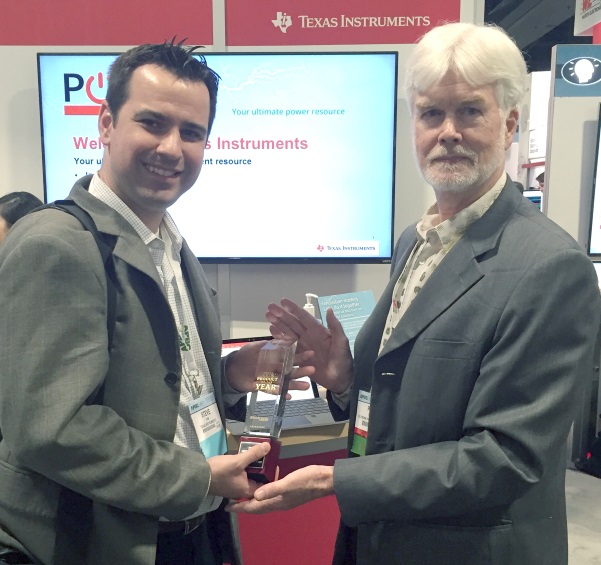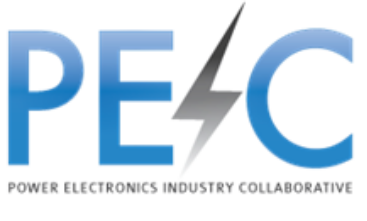By Paul O'Shea, Senior Technical Editor
One of the first things I did at APEC 2017 was have fun — I got to present an award to Steve Tom, manager of GaN products at Texas Instruments, for the LMG3410 GaN FET power stage.

Steve Tom, manager of GaN products, was thrilled to accept the Electronic Products Magazine Product of the Year award for his whole team from EP Editor Paul O’Shea.
Power Electronics Industry Collaborative (PEIC)

The mission of PEIC is to strengthen the U.S. power electronics industry through a combination of technology advancement, workforce development, and recommendations for government policies to support this critical segment of the semiconductor industry. The next major initiative planned for PEIC is to organize and present a special session at the upcoming IEEE Energy Conversion Congress & Exposition (October 1−5, 2017 in Cincinnati). The focus of the session will be on the unique workforce development challenges facing the power electronics industry and how to meet them, with participation by a cross-section of PEIC members from component manufacturers, materials suppliers, foundries, academia, and government labs.
Market and regulatory conditions have created global demand for power electronics systems that take advantage of new semiconductor technologies to enable higher efficiency devices that operate at higher temperatures, higher frequencies, and higher voltages in smaller packages and lower overall system cost. In order to meet these demands at scale, several technological and manufacturing challenges still need to be overcome. The PEIC group has a roadmap that provides an overview of these challenges, the current state of the art, and emerging solutions to achieve these benefits. Emphasis is placed on understanding trends, including interdependencies in semiconductors, capacitors, magnetics, and packaging technology. Using this information, this roadmap also presents key strategic recommendations for the U.S. to take advantage of these technological trends.
Wide-bandgap (WBG) semiconductors such as silicon carbide (SiC) and gallium nitride (GaN) offer the potential for smaller, more robust, higher-power devices that switch faster and are more energy-efficient than silicon (Si)-based devices. The development of WBG semiconductor devices is a major component of the global innovation race in power electronics. WBG semiconductor devices, especially SiC and GaN-on-Si devices, are beginning to penetrate the market, although Si devices continue to dominate the industry.
The U.S. WBG semiconductor device manufacturing supply chain is more developed in SiC device technology, while GaN-on-Si devices tend to be manufactured in Asian foundries, leveraging the massive Si device foundry infrastructure there.
Additionally, next-generation WBG semiconductors like bulk GaN and so-called ultra-wide-bandgap (UWBG) semiconductors like gallium oxide (Ga2 O3 ), aluminum gallium nitride (AlGaN), and diamond are in aggressive development as they promise additional performance advantages over SiC and GaN-on-Si.
Semiconductors are just one part of the overall power electronics system. While WBG and UWBG semiconductors are capable of operating at higher voltages and temperatures, today’s capacitors are not. Similarly, while WBG semiconductors are capable of operating at higher frequencies, today’s soft magnetics are not. Additionally, advances in packaging and thermal management are required before WBG semiconductors can be fully leveraged. The implication of improved semiconductor performance has ripple effects throughout the supply chain for power electronics.
The components that support the overall power electronics systems, including capacitors, magnetic components, and packaging technologies are being pushed to match the new semiconductor performance levels, which, in turn, is creating market conundrums that are hampering growth of advanced semiconductors.
Current capacitor technologies struggle to match the high temperature performance needs, as existing capacitor technologies are limited by the properties of the dielectric used. Consequently, this presents a global innovation white space for the discovery and development of materials that exhibit the desired properties with reliability and durability that can meet a variety of applications.
Ferrites are the dominant form of soft magnetics used in power electronics systems today, primarily due to their low cost. However, they are bulky, and reducing their size requires higher-frequency operation, which causes high losses. Amorphous alloys and nanocrystalline materials are being explored as potential solutions to this issue, but none of the materials developed exhibit the desired performance characteristics at a competitive cost yet.
New packaging techniques and materials are being developed to improve the performance of power electronics systems at high temperatures with improved reliability over many thermal cycles. These innovations focus on two critical areas of packaging, the die attach and the interconnection. In order to ensure reliability at higher temperature, new die attach techniques and materials are under development, including silver-tin alloy soldering, silver sintering, and embedded packaging. Current interconnection methods are also prone to failure and lose reliability at higher temperatures. New interconnection techniques are under development, including ribbon bonding, ball bonding, and embedded packaging.
The Complete Roadmap
The complete U.S. Power Electronics Technology and Manufacturing Roadmap explores these technology and market trends in detail and summarizes those trends in easy-to-understand technology and manufacturing roadmaps. Key challenges to and growth opportunities for the U.S. supply chain are identified and a number of detailed recommendations are made to close important gaps and to leverage positions of strength, all aimed toward strengthening the domestic power electronics ecosystem.
D3 Semiconductor has been working under the radar for several years (since 2011), has been in development since 2013, and is just now rolling out product. They have something very unique that is based on listening to small- to medium-sized companies who have trouble getting the support that they need for their new designs. For example, many design engineers need help with noise suppression for switching power supplies. Enter the D3 Semiconductor + FET superjunction MOSFET that enables wafer-level configurability to aid with circuit issues and provides hooks to offer mixed signal functions for more features. It doesn’t end there. The company can offer new designs that can be ready for reticle generation within hours. It also meets high-temperature reverse bias (HTRB) requirements of up to 4,000 hours. As you know, the HTRB test evaluates long-term stability under high drain-source bias and is intended to accelerate failure mechanisms. The device samples are stressed near the maximum-rated reverse breakdown voltage, usually to 1,000 hours, so 4,000 hours of this stress test is significant. D3 says that they have already retained global e-commerce distributors and agents for through-hole, surface-mount, and advanced surface-mount products with availability from Q2-2017 (April) to Q4. This was probably one of the more talked-about introductions. The company says that the initial product lineup offers high-performance superjunction MOSFETs that offer socket-for-socket alternatives to competitive parts. You can find a product table showing the initial +FET product line at: http://www.d3semi.com/MOSFET-Overview.
![]()
The long lead time associated with getting custom magnetics for the smaller customer usually means that these small-sized customers are constrained to off-the-shelf solutions. Because D3 allows these parameters to be specified dynamically and addressed upfront, they can help customers get a custom junction quickly. That means that they can spin variances in hours and not days, and parts are done in days, not weeks.
Some observations:
This is an interesting step for silicon superjunction MOSFETs. However, compared to GaN and some Si devices, it seems that the 77 nC Qg (gate charge) is somewhat high (so that means more power loss). Additionally, the output capacitance (Coss) and reverse recovery time (trr) are not mentioned, so high-frequency performance can’t be assessed. Obviously, when compared to GaN power ICs, they don’t look as good because GaN enables efficiency increases to 500 kHz and 1 MHz while offering a smaller size. Maybe we shouldn’t compare it to GaN but rather to silicon MOSFETs to get a more accurate comparison.
Texas Instruments offered many new products (as usual), so to get a good idea of what they featured, they created a video that provided a good video with a walk-through of their newest power products. Your tour guide, Rich Nowakowski, provides you with a rundown of the TI demos that were presented at APEC 2017.
Of note, TI introduced the first end-to-end high-frequency GaN power solution that includes:
- 1-kW totem pole PFC solution scalable to 3 kW with 99% efficiency and up to 4X the switching frequency of existing designs
- 1-MHz LLC isolated DC/DC stage delivering over 140 W/in3 of power density, or nearly 3X of today’s solutions
- 300-A stackable single-stage 48-V to POL DC/DC converter, eliminating intermediate bus (IBC) step and reducing the component count by more than 50%

Also, Bob Mammano introduced a new book: “Fundamentals of Power Supply Design,” which provides information from power supply design seminars (ISBN: 978-0-9985994-0-3).
This book is just chock full of very useful information, including chapters on switching control algorithms, designing magnetic components, dealing with electromagnetic noise, digital power control, and much more pertinent information for power design engineers.
Excelsys
Excelsys Technologies announced its Xsolo power supplies at APEC. What makes them special is that they are designed and tested to meet both the B- and BF-type requirements per the IEC 60601 standard. Meeting these requirements makes products suitable for applications that need to meet the performance for power supplies used in medical applications. Excelsys’ testing procedures were performed in accordance with requirements for B (body) and BF (body floating) medical end products. The goal of the testing was to help manufacturers optimize their medical designs to achieve the highest performance and safety levels, enabling first-pass success during agency approvals.

Excelsys meets medical requirements.
By testing the power supplies to the 60601 B and BF specification, the company helps manufacturers with the task of certifying the end medical device as an applied part for their intended applications, ensuring that the customer’s product is safe. It’s important because manufacturers often need to incorporate multiple power supplies into a given system and still meet stringent requirements. To help meet these requirements, Excelsys also offers low-leakage power supply versions, which enable designers to incorporate multiple power supplies into various medical-type rated systems.
Advertisement





